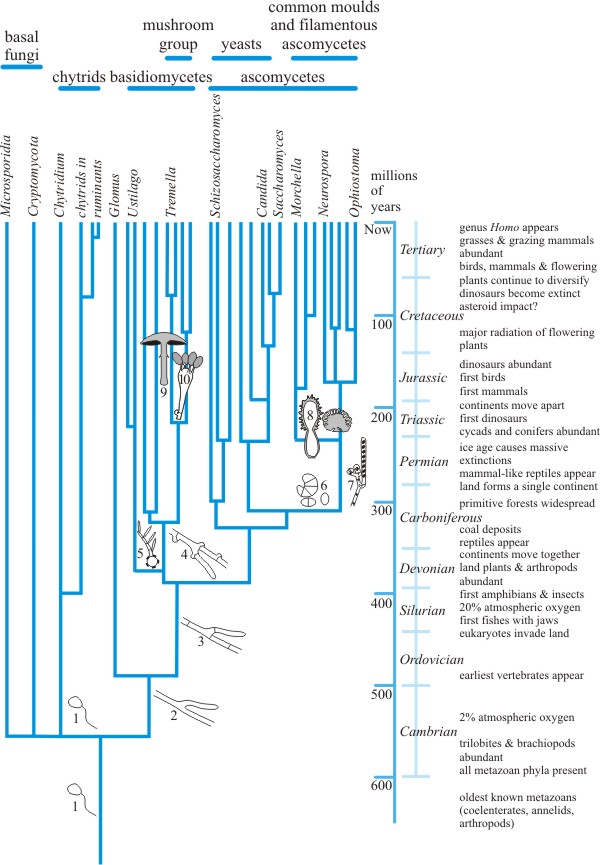We summarise fungal evolution in the cladogram and notes below. |
|
|
This phylogenetic tree summarises current ideas about the broad sweep of fungal evolution and puts it into context by showing some markers of geological time and animal and plant evolutionary features. This is a cladogram showing phylogeny of the true fungi largely based on the 18 S rDNA gene sequence but modified by phylogenomic analysis. Branch lengths in the cladogram are proportional to the average rate of nucleotide substitution (1% per 100 million years), so the cladogram becomes an evolutionary tree, which has been calibrated using fossil fungi, fungal hosts and/or symbionts.
The timescale on the right shows the context of other major evolutionary events in geological time. The numerals and cartoons on the cladogram illustrate major milestones of fungal morphological evolution: terrestrial higher fungi diverged from water moulds (1) as branching filaments without septa (2) about 550 million years ago (Mya); the Glomeromycotina diverged from the progenitor of ascomycetes and basidiomycetes about 490 Mya, and the latter lineage evolved septate filaments (3); clamp connections mark early basidiomycetes (4); basidia (smut-like, 5), asexual spores (6) and asci (7) probably evolved early in the major radiations of basidiomycetes and ascomycetes; filamentous ascomycetes diverged from the yeast lineage about 310 Mya, and fruiting bodies (8) presumably evolved before the Permian divergences because they are present in all the lineages today; mushroom fungi (9), with their characteristic holobasidium (10) probably radiated 130-200 Mya, soon after flowering plants became an important part of the flora. It is interesting to note that coals deposited in the Cretaceous and Tertiary periods show much more evidence of fungal decay than the much older Carboniferous coals, reflecting the radiation of aggressive wood decay basidiomycetes from the Triassic onwards. Also note the relatively recent radiation of (anaerobic) chytrids as grasses and grazing mammals became more abundant; and see our discussion of patterns of evolution of mushrooms in Section 3.8. |
Close the window to return to 21st Century Guidebook to Fungi
This is a Resources Box from the 21st Century Guidebook to Fungi: © David Moore, Geoffrey D. Robson and Anthony P. J. Trinci 2020
